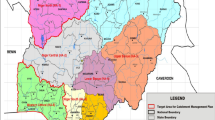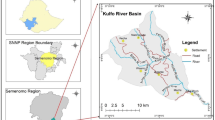Abstract
In-situ hydrometric gauges are considered the most trusted source of information in hydrology. They are crucial for effective planning, designing and management of water-related projects. In this study, we aim to identify important gauge locations of streamflow and sediment in the Ganga River Basin: (1) by identifying critical nodes (CN) which serve as pathways for the transport of water and sediment using the linear integer programming algorithm and (2) by identifying unique gauges among the 207 existing stream gauges based on the streamflow and sediment data using the complex network measure of clustering coefficient. We use 30 years of precipitation and temperature data to generate the streamflow and sediment data at the 207 stream gauge locations using the Soil and Water Assessment Tool (SWAT). Results show that the highest number of CN is found in the eastern zone of the basin, followed by the northern and southern zones. A total of 126 CN, 51 unique streamflow gauges, and 85 unique sediment gauge locations are identified. Combining the critical nodes and unique gauges, we identify 177 and 211 potential streamflow and sediment gauge locations in the basin, respectively. Results suggest the scope for adding streamflow and sediment gauges at the identified 126 CN locations. The study is important for policymakers for collecting and managing hydrological data, flood forecasters, and river management authorities for detecting sources of pollution, wastewater, etc.





Similar content being viewed by others
Availability of Data and Materials
The data would be made available on request.
References
Adhikary SK, Yilmaz AG, Muttil N (2015) Optimal design of rain gauge network in the Middle Yarra River catchment, Australia. Hydrol Process. John Wiley & Sons, Ltd, 29(11):2582–2599. https://doi.org/10.1002/HYP.10389
Agarwal A, Marwan N, Maheswaran R, Ozturk U, Kurths J, Merz B (2020) Optimal design of hydrometric station networks based on complex network analysis. Hydrol Earth Syst Sci 24(5):2235–2251. https://doi.org/10.5194/hess-24-2235-2020
Arulselvan A, Commander CW, Elefteriadou L, Pardalos PM (2009) Detecting critical nodes in sparse graphs. Comput Oper Res. Pergamon 36(7):2193–2200. https://doi.org/10.1016/J.COR.2008.08.016
Barca E, Passarella G, Vurro M, Morea A (2015) MSANOS: Data-Driven, multi-approach software for optimal redesign of environmental monitoring networks. Water Resour Manag. Kluwer Academic Publishers 29(2):619–644. https://doi.org/10.1007/S11269-014-0859-9/FIGURES/11
Chutiman N, Chiangpradit M, Kong-Ied B, Busababodhin P, Chaiyasaen C, Guayjarernpanishk P (2022) Daily maximum rainfall forecast affected by tropical cyclones using grey theory. Civ Eng J. Salehan Institute of Higher Education 8(8):1565–1573. https://doi.org/10.28991/CEJ-2022-08-08-02
Das S (2021) Dynamics of streamflow and sediment load in Peninsular Indian rivers (1965–2015). Sci Total Environ. Elsevier 799:149372. https://doi.org/10.1016/J.SCITOTENV.2021.149372
Faye C (2022) Comparative analysis of meteorological drought based on the SPI and SPEI Indices. 3. https://doi.org/10.28991/HIJ-SP2022-03-02
Godard V, Tucker GE, Burch Fisher G, Burbank DW, Bookhagen B, Godard V, Tucker GE, Fisher GB, Burbank DW, Bookhagen B (2013) Frequency-dependent landscape response to climatic forcing. Geophys Res Lett. John Wiley & Sons, Ltd 40(5):859–863. https://doi.org/10.1002/GRL.50253
Jha SK, Sivakumar B (2017) Complex networks for rainfall modeling: Spatial connections, temporal scale, and network size. J Hydrol. Elsevier B.V. 554:482–489. https://doi.org/10.1016/j.jhydrol.2017.09.030
Jha SK, Zhao H, Woldemeskel FM, Sivakumar B (2015) Network theory and spatial rainfall connections: An interpretation. J Hydrol. Elsevier B.V.,527:13–19. https://doi.org/10.1016/j.jhydrol.2015.04.035
Kar AK, Lohani AK, Goel NK, Roy GP (2015) Rain gauge network design for flood forecasting using multi-criteria decision analysis and clustering techniques in lower Mahanadi river basin, India. J Hydrol: Reg Stud. Elsevier 4:313–332. https://doi.org/10.1016/J.EJRH.2015.07.003
Keum J, Coulibaly P (2017) Information theory-based decision support system for integrated design of multivariable hydrometric networks. Water Resour Res. John Wiley & Sons, Ltd 53(7):6239–6259. https://doi.org/10.1002/2016WR019981
Krabbenhoft CA, Allen GH, Lin P, Godsey SE, Allen DC, Burrows RM, DelVecchia AG, Fritz KM, Shanafield M, Burgin AJ, Zimmer MA, Datry T, Dodds WK, Jones CN, Mims MC, Franklin C, Hammond JC, Zipper S, Ward AS, Costigan KH, Beck HE, Olden JD (2022) Assessing placement bias of the global river gauge network. Nat Sustain. Springer US. https://doi.org/10.1038/s41893-022-00873-0
Kumari M, Singh CK (2018) GaRiRO: Gradient and residual integrated rank ordering of stations in rainfall monitoring network. Earth Sci Inform. Springer Verlag 11(2):273–286. https://doi.org/10.1007/S12145-018-0332-Z/FIGURES/8
Li C, Singh VP, Mishra AK (2012) Entropy theory-based criterion for hydrometric network evaluation and design: Maximum information minimum redundancy. Water Resour Res. John Wiley & Sons, Ltd 48(5):5521. https://doi.org/10.1029/2011WR011251
Liu X, Hong Z, Liu J, Lin Y, Rodríguez-Patón A, Zou Q, Zeng X (2020) Computational methods for identifying the critical nodes in biological networks. Brief Bioinformatics. Oxford Academic 21(2):486–497. https://doi.org/10.1093/BIB/BBZ011
Mann R, Gupta A (2022) Temporal Trends of Rainfall and Temperature over Two Sub-Divisions of Western Ghats. HighTech Innov J. Ital Publication 3(0):28–42. https://doi.org/10.28991/HIJ-SP2022-03-03
Matomela N, Li T, Ikhumhen HO (2020) Siting of rainwater harvesting potential sites in Arid or Semi-arid Watersheds Using GIS-based Techniques. Environ Process. Springer 7(2):631–652. https://doi.org/10.1007/S40710-020-00434-7/FIGURES/9
Nguyen DT, Shen Y, Thai MT (2013) Detecting critical nodes in interdependent power networks for vulnerability assessment. IEEE Transactions on Smart Grid 4(1):151–159. https://doi.org/10.1109/TSG.2012.2229398
Nguyen LD, Nguyen HT, Dang PDN, Duong TQ, Nguyen LK (2021) Design of an automatic hydro-meteorological observation network for a real-time flood warning system: a case study of Vu Gia-Thu Bon River Basin, Vietnam. J Hydroinform. IWA Publishing 23(2):324–339. https://doi.org/10.2166/HYDRO.2021.124
Papamichail DM, Metaxa IG (1996) Geostatistical analysis of spatial variability of rainfall and optimal design of a rain gauge network. Water Resour Manag. Springer Netherlands 10(2):107–127. https://doi.org/10.1007/BF00429682/METRICS
Sarker S, Veremyev A, Boginski V, Singh A (2019) Critical nodes in river networks. Sci Rep. Springer US 9(1):11178. https://doi.org/10.1038/s41598-019-47292-4
Singh A, Jha SK (2021) Identification of sensitive parameters in daily and monthly hydrological simulations in small to large catchments in Central India. J Hydrol. Elsevier 601:126632. https://doi.org/10.1016/J.JHYDROL.2021.126632
Singhal A, Jaseem M, Jha SK (2023) Spatial connections in extreme precipitation events obtained from NWP forecasts: A complex network approach. Atmos Res. Elsevier 282:106538. https://doi.org/10.1016/J.ATMOSRES.2022.106538
Singhal A, Jha SK (2021) An application of Multiple‐point statistics downscaling approach over North‐West Himalayas in avalanche‐prone areas. Int J Climatol (June):1–20. https://doi.org/10.1002/joc.7342
Sivakumar B, Woldemeskel FM (2014) Complex networks for streamflow dynamics. Hydrol Earth Syst Sci 11(7):7255–7289. https://doi.org/10.5194/hessd-11-7255-2014
Sreeparvathy V, Srinivas VV (2020) A fuzzy entropy approach for design of hydrometric monitoring networks. J Hydrol. Elsevier 586:124797. https://doi.org/10.1016/J.JHYDROL.2020.124797
Sreeparvathy V, Srinivas VV (2022) A Bayesian fuzzy clustering approach for design of precipitation gauge network using merged remote sensing and ground-based precipitation products. Water Resour Res. John Wiley & Sons, Ltd 58(2):e2021WR030612. https://doi.org/10.1029/2021WR030612
Theochari AP, Feloni E, Bournas A, Baltas E (2021) Hydrometeorological - Hydrometric station network design using multicriteria decision analysis and GIS techniques. Environ Process. Springer Science and Business Media Deutschland GmbH 8(3):1099–1119. https://doi.org/10.1007/S40710-021-00527-X/TABLES/4
Tiwari S, Jha SK, Singh A (2020) Quantification of node importance in rain gauge network: influence of temporal resolution and rain gauge density. Sci Rep 10(1):1–17. https://doi.org/10.1038/s41598-020-66363-5
Veremyev A, Boginski V, Pasiliao EL (2014a) Exact identification of critical nodes in sparse networks via new compact formulations. Optim Lett. Springer Verlag 8(4):1245–1259. https://doi.org/10.1007/S11590-013-0666-X/TABLES/3
Veremyev A, Prokopyev OA, Pasiliao EL (2014b). An integer programming framework for critical elements detection in graphs. J Comb Optim 28(1). https://doi.org/10.1007/s10878-014-9730-4
Vivekanandan N, Jagtap RS (2012) Evaluation and selection of rain gauge network using entropy. J Inst Eng (India): A. Springer India 93(4):223–232. https://doi.org/10.1007/S40030-013-0032-0/TABLES/3
Volkmann THM, Lyon SW, Gupta HV, Troch PA (2010) Multicriteria design of rain gauge networks for flash flood prediction in semiarid catchments with complex terrain. Water Resour Res. John Wiley & Sons, Ltd 46(11):11554. https://doi.org/10.1029/2010WR009145
Yeh HC, Chen YC, Chang CH, Ho CH, Wei C (2017) Rainfall network optimization using radar and entropy. Entropy. Multidisciplinary Digital Publishing Institute 19(10):553. https://doi.org/10.3390/E19100553
Funding
Akshay Singhal acknowledges the financial support from the Department of Science and Technology, Government of India (DST/INSPIRE/03/ 2019/001343) (IF 190257) under the DST-INSPIRE scheme to conduct this research. Sanjeev Kumar Jha thanks the support by the Science and Engineering Research Board (SERB), Department of Science and Technology, Government of India (CRG/2022/004006).
Author information
Authors and Affiliations
Contributions
A Singhal: Conceptualization, Formal analysis, Writing – original draft, Investigation, Visualization, Writing and editing manuscript, Funding acquisition; M Jaseem: Formal analysis, Investigation, Visualization, Data curation; D Singh: Formal analysis, Investigation, Visualization; S Sarker: Conceptualization, Methodology, Validation, Writing and editing manuscript; P Prajapati: Formal analysis, Visualization; A Singh: Formal analysis, Data curation; S Jha: Conceptualization, Methodology, Validation, Writing and editing manuscript, Supervision, Funding acquisition. All authors read and approved the manuscript.
Corresponding author
Ethics declarations
Ethical Approval
Not applicable.
Consent to Participate
The authors declare that they agree with the participation in the journal.
Consent to Publish
The authors declare that they agree with the publication of this paper in this journal.
Competing Interests
The authors declare that they have no competing interests to disclose.
Additional information
Publisher's Note
Springer Nature remains neutral with regard to jurisdictional claims in published maps and institutional affiliations.
Supplementary Information
Below is the link to the electronic supplementary material.
Rights and permissions
Springer Nature or its licensor (e.g. a society or other partner) holds exclusive rights to this article under a publishing agreement with the author(s) or other rightsholder(s); author self-archiving of the accepted manuscript version of this article is solely governed by the terms of such publishing agreement and applicable law.
About this article
Cite this article
Singhal, A., Jaseem, M., Divya et al. Identifying Potential Locations of Hydrologic Monitoring Stations Based on Topographical and Hydrological Information. Water Resour Manage 38, 369–384 (2024). https://doi.org/10.1007/s11269-023-03675-x
Received:
Accepted:
Published:
Issue Date:
DOI: https://doi.org/10.1007/s11269-023-03675-x




